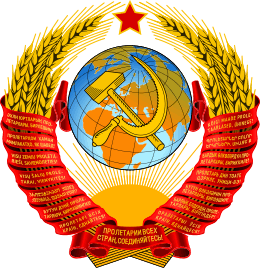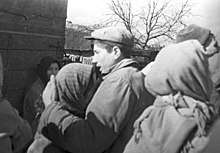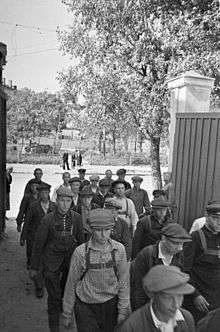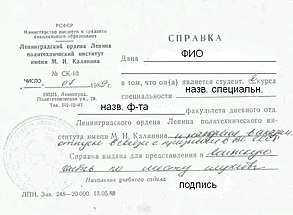Conscription in the Soviet Union
Conscription was used by the Soviet Union for the duration of its existence to bolster military function and operations. Conscription was introduced into what would become the Soviet Union in 1918,[1] almost immediately after the Bolshevik Revolution of 1917 to strengthen the forces of the Red Army. Following its introduction, conscription remained a constant presence in the Soviet state until its dissolution in 1991. Various policy amendments changed the volume of conscription intakes and the required length of service, with key changes to policy occurring in 1918, 1938 and 1967.[2] Wartime conscription, specifically during World War II, saw a significant increase in conscription intake as well as a broadening of the pool of candidates available to be conscripted.[3] Unlike in countries without a consistent history of conscription (such as the United States), there was relatively little resistance to conscription policy, as the concept was enshrined in the Soviet constitution as a mandatory requirement of citizenship, regardless of identity or status, and was seen as the national duty of all Soviet military-aged men.
| This article is part of a series on the |
| Politics of the Soviet Union |
|---|
 |
|
Leadership |
|
Governance |
Historical periods
1917–1939
After the Bolshevik Revolution in Russia in 1917, the new communist government briefly experimented with a volunteer system of army recruitment but returned to the former system of conscription almost immediately in May 1918.[1]
The policy saw few changes until September 1, 1939, when a new Law on Universal Military Service was enacted following the outbreak of WWII across Europe.[3] This new law saw large increases in terms of service periods, ages of conscription and a restriction of potential exemptions. The general period of service was increased from 2 to 3 years, and conscription age was lowered from 19 to 17 for young boys.[4] Previous exemptions for those pursuing higher education were abolished, as well as exemptions on the grounds of family reasons (such as having several young children). The plan behind the increased conscription terms was to create two large groups of trained reserves, one for men up to 40 years of age, and the other for men up to 50 years of age.[4]
World War II

The Soviet Union officially entered World War II on June 22, 1941, when Germany launched a surprise attack against their western border.[5] Soon after, in October 1941 the government passed a new military service law which states that all male citizens from the ages of 16 to 28 were liable for military service.[6]
On 9 February 1942, Stalin issued an order which stated it would be expedient to “conscript into the ranks of the Red Army… citizens in the liberated territories between the ages of 17 to 30 who have not been conscripted into the Red Army during the previous months of the war” due to the fact they were “burning with hatred for the invader and a desire to participate in the subsequent liberation of their Soviet Motherland with weapons in their hands.”[3] Following this order, non-Russian inhabitants of liberated territory began to be forcibly conscripted into the Red Army ranks as it moved westward toward Germany.[7]
This broadening of the conscription pool created a diverse range of military personnel along the front lines, with soldiers of many different nationalities, ethnicities and languages being present.

1945–1991
In 1950 a secretive amendment to the service law saw the term of active service increased by one year. It is speculated that this increase was a response to America’s involvement in the Korean war, however was chosen to be kept off of official records such as the Proceedings of the Supreme Soviet (link) so that the US would not learn of the increase and suspect the Soviet Union of preparing for war themselves.[8] Then in 1955, the service term was reduced back down to three years from four in the air forces, coast-guard and coastal defence, and to four years from five in the Navy. This decision again was kept off official records, but was presumably part of the planned cut in manpower forces, announced in August 1955 and May 1956[8]
On 12 October 1967 a major amendment to the service law saw service periods shortened from 3 years to 2, and also saw the frequency of call-ups increase to twice per year. This amendment is said to have been caused by the large increase in young men reaching military age around this time. In order to adhere to the concept of ‘universal service’ whilst maintain the size of the armed forces, conscript turnover was increased so that a large majority of boys reaching military age were still conscripted to serve, but not at the expense of increasing the size of the armed forces by unnecessary proportions.[8]
Following the 1967 amendment, conditions for conscripts worsened considerably, with reports of abuse, hazing and even murder of conscripted soldiers becoming widespread.[2] Conscripted soldiers, particularly those in their first year of service who had not yet earned either rank or respect to protect them, faced physical violence and sexual assault from superior officers, and regularly had their pay and food rations confiscated. Any resistance to such abuse was met with beatings, sometimes resulting in severe injuries, disability discharges and even death.[2]
The official system of promoting some just recruited able soldiers to sergeants so that they were already in commanding positions shortly after enrollment into the armed forces, was undermined by an unofficial system structured around the years of service spent by each conscript. Junior conscripts became the subordinates to more experienced conscripts who had already served one or two years. This system was not recognised, however it became entrenched in conscript culture during the 1970s and 1980s.[2]

Traditionally, all full-time Soviet students benefited from a draft postponement until graduation. If the college/university had a military chair (which provided training in a particular military specialty), its students became reserve officers and exemption from service as soldiers. Without a military chair the graduates were conscripted for shortened term. For many people, an intention to avoid or at least to defer soldier service was the main reason for studying.
However between late autum 1982 and 1988 Soviet Union had the mandatory draft for students of the most universities[9][10] with the peak conscription fraction in 1987. Students were drafted for two or, if for the navy, three years of soldier service typically after termination of the first or second academic year.
Conscription of Women
The Soviet Union conscripted the most women for combat, comparative to other national military during wartime[11] and especially during WWII. It is difficult to know the exact number of women conscripted during WWII and in what roles they served, as information about female soldiers was generally repressed in official reports and government documents from that period. However recently efforts have been made to uncover and rectify the records of female service personnel in the Soviet Union.[3]
In the 1938 amendment to the service law, it was stated that any woman with relevant training and education, such as medical or mechanical would be liable for conscription service during times of war.[4] Three all-female aviation unit were formed in late 1941 after an official decree from Stalin on the 8th of October 1941.[3] This was only 4 months after the Soviet Union officially entered WWII, and by late march 1942 over 100,000 women had already been conscripted into air defence units.[11] By the end of the war, the air defence force was more than 1/4 female, with 300,000 women, both volunteers and conscripts serving as communicators, machine gunners, pilots and medical personnel.[12] Most female conscripts served behind the front lines in secondary positions and roles in an attempt to free up more men for front line duty. However it is believed that many women also served in combat positions, such as in tank regiments or along the front line.[3]
The increased female presence in the armed forces during WWII also led to an improvement in sanitary conditions. On the 11th of April 1943 it was ordered that soap rations for women personnel be increased to 100 grams per month, 50% more than their male counterparts.[3]
Resistance to Conscription
The first widespread and organised resistance to conscription policy began in the 1980's due to the growing public awareness of the harsh conditions faced by conscripted soldiers, as well as the loosening of government restrictions on things such as public organisations and freedom of speech under the Perestroika and Glasnost reforms. Within the armed forces resistance grew in the form of organised ethnic and nationality groups in order to protect each other from abuse and call attention to the treatment suffered by conscripts.[2] In October 1989 a group of junior officers formed the Union for the Social Protection of Servicemen and their Families which publicised conscripts stories and conducted protests against government handling of the conscription policy.[2]
Outside of the armed forces, the most prolific public group which spoke out against conscription was the Committee of Soldiers Mothers, later changed to the Union of the Committees of Soldiers' Mothers of Russia in 1998. The group was founded in 1989 and aimed to record and publicise the treatment of conscripts within training and barracks centres. The group also organised public protests and called for government action to protect the rights of soldiers and conscripts whilst they served.
Conscription methods
| Conscription |
|---|
| Conscription by country |
In times of peace, the general conscription method was to conscript young boys, either 19 or 18 who had just finished high school or completed a trade. Under the 1938 law, one call up was conducted each year in October/November to induct conscripts for three years of service, unless they were in the Navy for which service terms were 4 years.[2] These terms of service changed over the history of the Soviet Union as new drafts to the service law were enacted to reflect the growing and diminishing populations and external threat levels. Programs conducted by the government in elementary and secondary school usually meant that newly conscripted privates had already received a degree of military training and could bypass the usual basic training.[2]
However in times of war, specifically WWII, conscription methods became a lot less bureaucratic, with anyone who appeared to be of age forcibly conscripted from areas that had been taken back from German control.[3] Soldiers in these liberated areas would comb haystacks, search forests etc. for those thought to be evading service.[3]
See also
- Conscription in Russia
- Military history of the Soviet Union
- Soviet Union
- Category:Conscription by country
References
- Jones, Ellen (1982). "Manning the Soviet Military". International Security. 7 (1): 105–131. doi:10.2307/2538691. ISSN 0162-2889. JSTOR 2538691.
- Spivak, Andrew L.; Pridemore, William Alex (2004-11-01). "Conscription and Reform in the Russian Army". Problems of Post-Communism. 51 (6): 33–43. doi:10.1080/10758216.2004.11052188. ISSN 1075-8216.
- Glantz, David (2012-08-14), "Soviet Use of "Substandard" Manpower in the Red Army, 1941–1945", Scraping the Barrel, Fordham University Press, pp. 151–178, doi:10.5422/fordham/9780823239771.003.0008, ISBN 9780823239771
- "Conscription age set at 17 in Russia". The New York Times. 1 September 1939. ProQuest 103062450.
- "Invasion of the Soviet Union, June 1941". encyclopedia.ushmm.org. Retrieved 2019-05-06.
- Reese, Roger R. (2007-05-31). "Motivations to Serve: The Soviet Soldier in the Second World War". The Journal of Slavic Military Studies. 20 (2): 263–282. doi:10.1080/13518040701378287. ISSN 1351-8046.
- Glantz, David (2012-08-14), "Soviet Use of "Substandard" Manpower in the Red Army, 1941–1945", Scraping the Barrel, Fordham University Press, pp. 151–178, doi:10.5422/fordham/9780823239771.003.0008, ISBN 9780823239771
- Jukes, G. (August 1968). "Changes in Soviet conscription law". Australian Outlook. 22 (2): 204–217. doi:10.1080/10357716808444315. ISSN 0004-9913.
- Steven W. Popper. "The Economic Cost of Soviet Military Manpower Requirements" (PDF). United States Air Force. Retrieved 27 December 2018.
- "Soviets halting student military draft". Retrieved 2018-12-26.
- Marble, Sanders, "Filling the ranks: conscription and personnel policies", The Cambridge History Of The Second World War, Cambridge University Press, pp. 585–607, doi:10.1017/cho9781139855969.025, ISBN 9781139855969
- "Velikaia Otechestvennaia Voina Sovetskogo Soiuza, 1941–1945: Kratkaia Istoriia [The Great Fatherland War of the Soviet Union, 1941–1945: A Concise History]. Edited by <italic>P. I. Pospelov et al</italic>. [Institut Marksizma-Leninizma pri TsK KPSS, Otdel Istorii Velikoi Otechestvennoi Voiny.] (Moscow: Voennoe Izdatel'stvo Ministerstva Oborony SSSR. 1965. Pp. 617)". The American Historical Review. April 1968. doi:10.1086/ahr/73.4.1210. ISSN 1937-5239.